How to eliminate MrAnon stealer-type malware from the operating system
TrojanAlso Known As: MrAnon malware
Get free scan and check if your device is infected.
Remove it nowTo use full-featured product, you have to purchase a license for Combo Cleaner. Seven days free trial available. Combo Cleaner is owned and operated by RCS LT, the parent company of PCRisk.com.
What kind of malware is MrAnon?
MrAnon is the name of an information-stealing malware written in the Python programming language. This stealer has a variety of data-extracting capabilities and targets information from browsers, cryptocurrency wallets, messengers, and other applications.
At the time of writing, MrAnon's developers are offering it for sale online; hence, there are several variants with different functionalities based on the payment plan. It is pertinent to mention that this malware has been observed being proliferated via email spam campaigns.
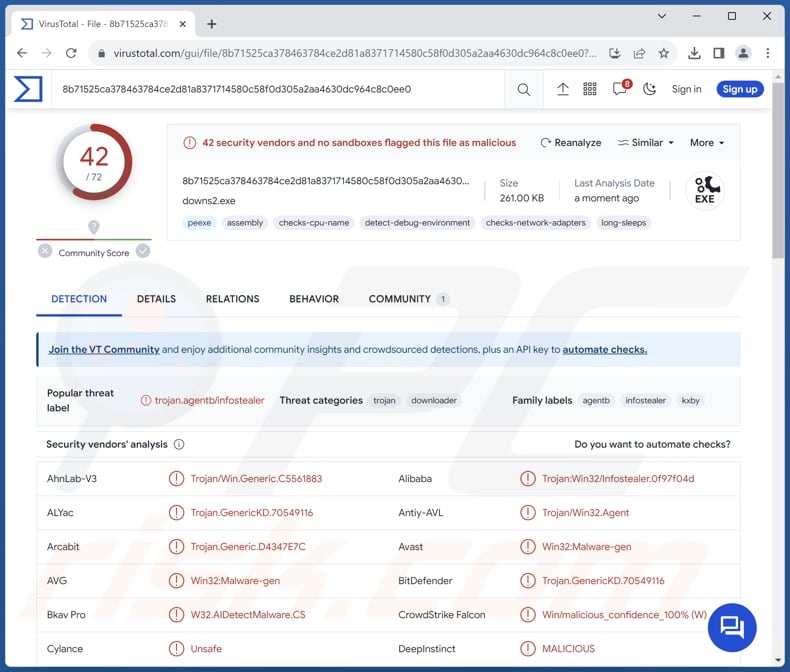
MrAnon malware overview
Following successful infiltration, MrAnon can display a pop-up window stating "File Not Supported", succeeded by another one claiming "Not Run: python.exe". These messages are used to mislead victims into thinking that the potential malware installation on their devices failed. Thus, a false sense of security is created, diminishing the chances of users taking additional actions to secure their systems.
MrAnon malware begins its operations by searching and terminating processes of interest, such as those associated with targeted apps like browsers, messengers, cryptowallets, etc.
This stealer gathers relevant device data. One of the methods utilized is stealthily visiting legitimate websites to acquire the victim's IP address (geolocation), as well as their country name and code. MrAnon may arrive onto systems heavily compressed, and its small file size can aid in evading detection.
The malicious program is capable of downloading files from infected devices. It checks the following locations – Desktop, Documents, Pictures, and Downloads – for these formats: 7z, BMP, CONF, CSV, DAT, DB, DOC, JPEG, JPG, KDBX, KEY, ODT, OVPN, PDF, PNG, RAR, RDP, RTF, SQL, TAR, TXT, WALLET, XLS, XLSX, XLM, ZIP, etc.
Taking screenshots is also among the stealer's capabilities. MrAnon can extract information from over twenty browsers (full list). Data of interest may include: browsing and search engine histories, Internet cookies, usernames/passwords, personally identifiable details, credit card numbers, etc.
It also targets both desktop and browser extension cryptocurrency wallets (full list). Additionally, the stealer seeks data from messengers, authentication software, password managers, VPN (Virtual Private Network) clients, gaming-related software, and FTP (File Transfer Protocol) clients (full list).
The information obtained by MrAnon is compressed into a file(s) and uploaded to a file-hosting site; a message notifying of the creation and including the download link is then sent to the attackers' Telegram.
It is noteworthy that malware developers often improve upon their software; therefore, potential future iterations of MrAnon could have additional/different functionalities and features.
To summarize, the presence of malware like the MrAnon stealer on devices can lead to severe privacy issues, financial losses, and identity theft.
| Name | MrAnon malware |
| Threat Type | Trojan, stealer, password-stealing virus, spyware. |
| Detection Names | Avast (Win32:Malware-gen), Combo Cleaner (Trojan.GenericKD.70549116), ESET-NOD32 (PowerShell/TrojanDownloader.Agent.HRU), Kaspersky (Trojan.Win64.Agentb.kxby), Symantec (Infostealer.Limitail), Full List Of Detections (VirusTotal) |
| Symptoms | Trojans are designed to stealthily infiltrate the victim's computer and remain silent, and thus no particular symptoms are clearly visible on an infected machine. |
| Distribution methods | Infected email attachments, malicious online advertisements, social engineering, software 'cracks'. |
| Damage | Stolen passwords and banking information, identity theft, the victim's computer added to a botnet. |
| Malware Removal (Windows) |
To eliminate possible malware infections, scan your computer with legitimate antivirus software. Our security researchers recommend using Combo Cleaner. Download Combo CleanerTo use full-featured product, you have to purchase a license for Combo Cleaner. 7 days free trial available. Combo Cleaner is owned and operated by RCS LT, the parent company of PCRisk.com. |
Stealer-type malware examples
Vare, Ansiety, Epsilon, Laze, Serpent, and TrapStealer are merely some examples of stealers we have written about recently. Information-stealing malware can target incredibly specific details or a broad range of data. These programs could have other capabilities, as malware is not limited by its classification.
It must be emphasized that regardless of how malicious software operates – its presence on a system threatens device integrity and user safety. Therefore, all threats must be removed immediately upon detection.
How did MrAnon infiltrate my computer?
As mentioned in the introduction, MrAnon has been noted being proliferated via spam emails. One of the known campaigns involved missives regarding a hotel reservation supposedly booked by the recipients. The emails with the subject "December Room Availability Query" (may vary) included malicious PDF document attachments titled "Booking.pdf".
Upon opening, the document's background depicted what appeared to be scans of an ID and a credit/debit card; a pop-up was displayed in the foreground. The text in this window stated that "Adobe Flash Player" was outdated, and the user was urged to update it.
Interacting with this pop-up triggered the malware download/installation process. The PDF downloaded a .NET executable, which retrieved and executed several PowerShell scripts. The chain culminated in the installation of the MrAnon stealer.
It must be mentioned that other lures or files could be used to spread MrAnon. Aside from emails, malware can be distributed through DMs/PMs, SMSes, and other messages.
Infectious files can be attached to or linked inside spam mail. These files come in various formats, e.g., executables (.exe, .run, etc.), archives (ZIP, RAR, etc.), documents (Microsoft Office, Microsoft OneNote, PDF, etc.), JavaScript, and so on.
Other common malware proliferation methods include: drive-by (stealthy/deceptive) downloads, online scams, malvertising, untrustworthy download channels (e.g., freeware and free file-hosting websites, P2P sharing networks, etc.), illegal program activation tools ("cracks"), and fake updates.
Furthermore, some malicious programs can self-spread via local networks and removable storage devices (e.g., USB flash drives, external hard drives, etc.).
How to avoid installation of malware?
We recommend treating incoming emails and other messages with care. Attachments or links present in dubious/irrelevant mail must not be opened, as they can be malicious. Another recommendation is to be cautious while browsing since fake and dangerous online content usually appears legitimate and innocuous.
Additionally, all downloads must be performed from official and verified sources. We advise activating and updating programs by using genuine functions/tools, as illegal activation ("cracking") tools and third-party updaters may contain malware.
We must stress the importance of having a dependable anti-virus installed and kept up-to-date. Security software must be used to run regular system scans and to remove threats and issues. If you believe that your computer is already infected, we recommend running a scan with Combo Cleaner Antivirus for Windows to automatically eliminate infiltrated malware.
Targeted browsers:
Google Chrome, Mozilla Firefox, Microsoft Edge, Opera, 7Star, Amigo, Brave, Cent Browser, Chrome Canary, Epic Privacy Browser, Iridium, Kometa, Opera GX, Orbitum, Pale Moon, SeaMonkey, Sputnik, Torch, Uran, Vivaldi, Waterfox, and Yandex.
Targeted cryptowallets and cryptocurrency-related browser extensions:
Aergo Connect, Armory, Atomic, Auro, Binance, BitKeep, BoltX, BlockWallet, Braavos, Bytecoin Wallet, CLV Wallet, Coin98, Coinbase, Cyano, Coinomi, Enkrypt, Eternl, EVER, Exodus, Fewcha Move, Finnie, GeroWallet, Goby, Guarda, HashPack, HAVAH, ICONex, iWallet, Jaxx Liberty, KardiaChain, Keeper, Keplr, KHC Wallet, Leap Terra, Liquality, MadWallet, Math, MetaMask, Meta Wallet, MEW CX, MultiversX DeFi Wallet, Nami, NeoLine, Nifty, OKX Wallet, OsmWallet, Pali, Petra Aptos, Phantom, Polygon, Polymesh, Pontem Aptos, Rabby, Ronin, SafePal, Sender Wallet, Solflare, Station, Sui, Tally Ho, Temple, TexBox, Tronium, Tron Link, Trust, Virgo, WAGMIswap.io, Wombat, XDEFI, and Yoroi.
Other targeted browser extensions:
Authenticator, Authy, EOS Authenticator, GAuth Authenticator, Bitwarden, KeePassHelper, KeePass Tusk, KeePassXC, Trezor Password Manager, Microsoft Autofill, NordVPN, and Proton VPN.
Targeted messaging software:
Discord, Discord Canary, Element, Signal, and Telegram.
Targeted miscellaneous software:
FileZilla, FileZilla Server, NordVPN, OpenVPN Connect, ProtonVPN, and Steam.
Screenshot of the Telegram account used by MrAnon stealer's developers:
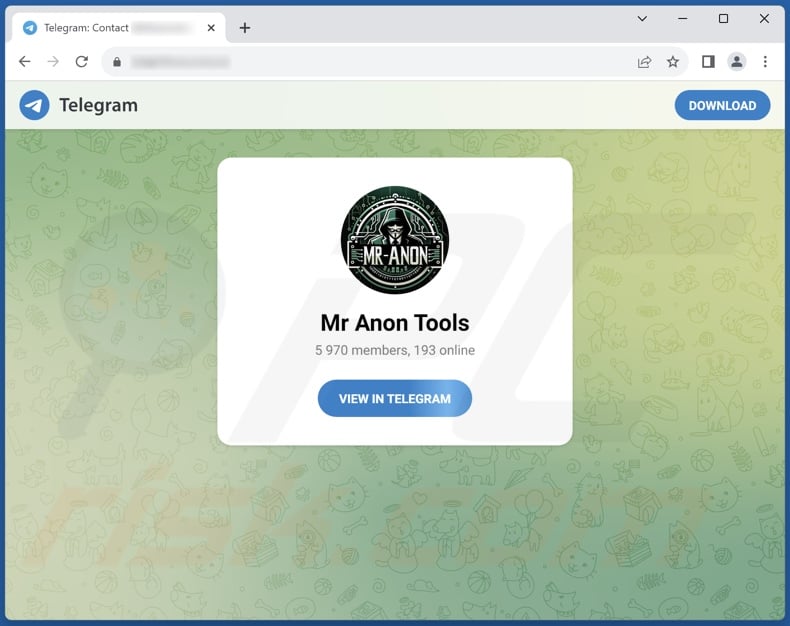
Screenshot of MrAnon stealer being sold online:
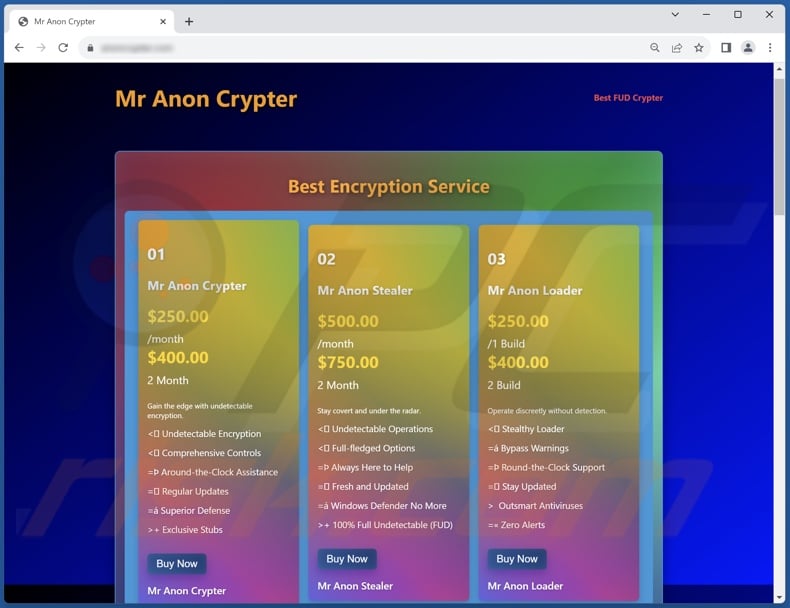
Screenshot of a spam email used to proliferate MrAnon stealer:
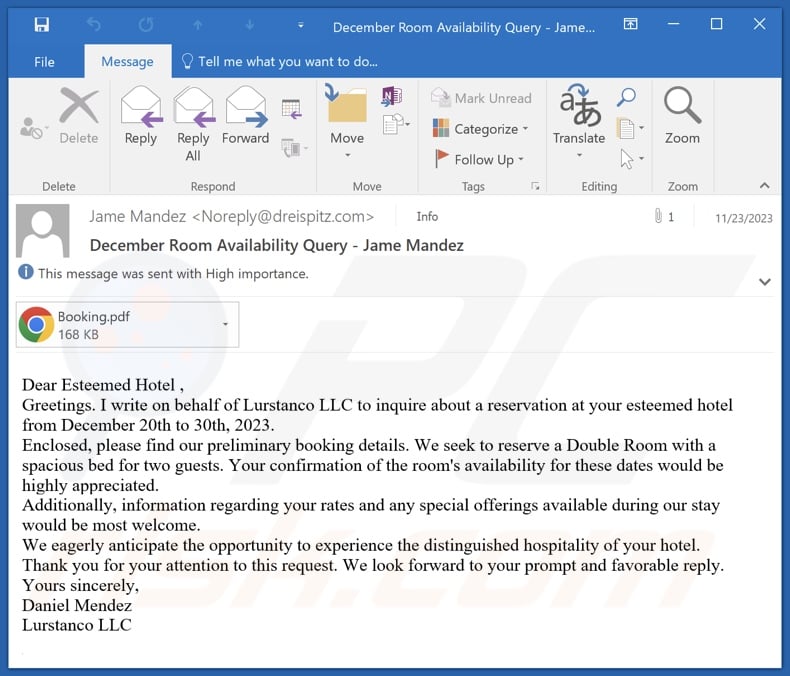
Text presented in this email letter:
Subject: December Room Availability Query - Jame Mandez
Dear Esteemed Hotel ,
Greetings. I write on behalf of Lurstanco LLC to inquire about a reservation at your esteemed hotel from December 20th to 30th, 2023.
Enclosed, please find our preliminary booking details. We seek to reserve a Double Room with a spacious bed for two guests. Your confirmation of the room's availability for these dates would be highly appreciated.
Additionally, information regarding your rates and any special offerings available during our stay would be most welcome.
We eagerly anticipate the opportunity to experience the distinguished hospitality of your hotel.
Thank you for your attention to this request. We look forward to your prompt and favorable reply.
Yours sincerely,
Daniel Mendez
Lurstanco LLC
Screenshot of the malicious PDF attached to this spam email ("Booking.pdf"):
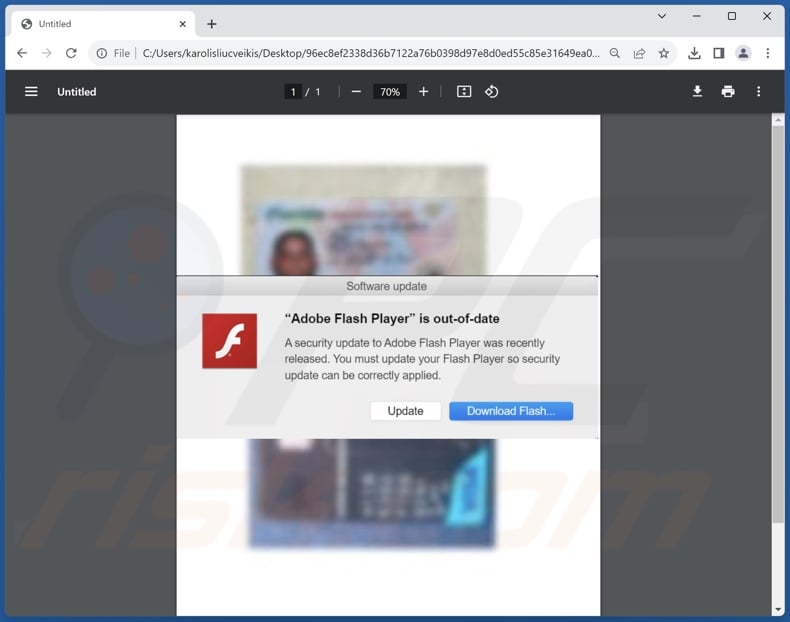
Instant automatic malware removal:
Manual threat removal might be a lengthy and complicated process that requires advanced IT skills. Combo Cleaner is a professional automatic malware removal tool that is recommended to get rid of malware. Download it by clicking the button below:
DOWNLOAD Combo CleanerBy downloading any software listed on this website you agree to our Privacy Policy and Terms of Use. To use full-featured product, you have to purchase a license for Combo Cleaner. 7 days free trial available. Combo Cleaner is owned and operated by RCS LT, the parent company of PCRisk.com.
Quick menu:
How to remove malware manually?
Manual malware removal is a complicated task - usually it is best to allow antivirus or anti-malware programs to do this automatically. To remove this malware we recommend using Combo Cleaner Antivirus for Windows.
If you wish to remove malware manually, the first step is to identify the name of the malware that you are trying to remove. Here is an example of a suspicious program running on a user's computer:

If you checked the list of programs running on your computer, for example, using task manager, and identified a program that looks suspicious, you should continue with these steps:
 Download a program called Autoruns. This program shows auto-start applications, Registry, and file system locations:
Download a program called Autoruns. This program shows auto-start applications, Registry, and file system locations:

 Restart your computer into Safe Mode:
Restart your computer into Safe Mode:
Windows XP and Windows 7 users: Start your computer in Safe Mode. Click Start, click Shut Down, click Restart, click OK. During your computer start process, press the F8 key on your keyboard multiple times until you see the Windows Advanced Option menu, and then select Safe Mode with Networking from the list.

Video showing how to start Windows 7 in "Safe Mode with Networking":
Windows 8 users: Start Windows 8 is Safe Mode with Networking - Go to Windows 8 Start Screen, type Advanced, in the search results select Settings. Click Advanced startup options, in the opened "General PC Settings" window, select Advanced startup.
Click the "Restart now" button. Your computer will now restart into the "Advanced Startup options menu". Click the "Troubleshoot" button, and then click the "Advanced options" button. In the advanced option screen, click "Startup settings".
Click the "Restart" button. Your PC will restart into the Startup Settings screen. Press F5 to boot in Safe Mode with Networking.

Video showing how to start Windows 8 in "Safe Mode with Networking":
Windows 10 users: Click the Windows logo and select the Power icon. In the opened menu click "Restart" while holding "Shift" button on your keyboard. In the "choose an option" window click on the "Troubleshoot", next select "Advanced options".
In the advanced options menu select "Startup Settings" and click on the "Restart" button. In the following window you should click the "F5" button on your keyboard. This will restart your operating system in safe mode with networking.

Video showing how to start Windows 10 in "Safe Mode with Networking":
 Extract the downloaded archive and run the Autoruns.exe file.
Extract the downloaded archive and run the Autoruns.exe file.

 In the Autoruns application, click "Options" at the top and uncheck "Hide Empty Locations" and "Hide Windows Entries" options. After this procedure, click the "Refresh" icon.
In the Autoruns application, click "Options" at the top and uncheck "Hide Empty Locations" and "Hide Windows Entries" options. After this procedure, click the "Refresh" icon.

 Check the list provided by the Autoruns application and locate the malware file that you want to eliminate.
Check the list provided by the Autoruns application and locate the malware file that you want to eliminate.
You should write down its full path and name. Note that some malware hides process names under legitimate Windows process names. At this stage, it is very important to avoid removing system files. After you locate the suspicious program you wish to remove, right click your mouse over its name and choose "Delete".

After removing the malware through the Autoruns application (this ensures that the malware will not run automatically on the next system startup), you should search for the malware name on your computer. Be sure to enable hidden files and folders before proceeding. If you find the filename of the malware, be sure to remove it.

Reboot your computer in normal mode. Following these steps should remove any malware from your computer. Note that manual threat removal requires advanced computer skills. If you do not have these skills, leave malware removal to antivirus and anti-malware programs.
These steps might not work with advanced malware infections. As always it is best to prevent infection than try to remove malware later. To keep your computer safe, install the latest operating system updates and use antivirus software. To be sure your computer is free of malware infections, we recommend scanning it with Combo Cleaner Antivirus for Windows.
Frequently Asked Questions (FAQ)
My computer is infected with MrAnon malware, should I format my storage device to get rid of it?
No, malware removal seldom requires formatting.
What are the biggest issues that MrAnon malware can cause?
The dangers associated with an infection depend on the malware's functionalities and the cyber criminals' interference. MrAnon is a stealer – a type of malware that extracts and exfiltrates data (e.g., log-in credentials, cryptowallets, etc.). Generally, infections of this kind can lead to severe privacy issues, financial losses, and identity theft.
What is the purpose of MrAnon malware?
Malware is usually used to generate revenue. However, cyber criminals can also utilize malicious software to amuse themselves, carry out personal vendettas, disrupt processes (e.g., websites, services, companies, etc.), and even launch politically/geopolitically motivated attacks.
How did MrAnon malware infiltrate my computer?
MrAnon has been observed being spread via malicious attachments in hotel booking themed spam emails. However, other distribution methods are not unlikely.
Aside from spam mail, malware is widely distributed through drive-by downloads, online scams, dubious download channels (e.g., freeware and free file-hosting sites, P2P sharing networks, etc.), illegal software activation tools ("cracks"), fake updaters, and malvertising. Some malicious programs can even self-proliferate via local networks and removable storage devices.
Will Combo Cleaner protect me from malware?
Yes, Combo Cleaner is capable of detecting and eliminating nearly all known malware infections. Note that running a complete system scan is crucial since high-end malicious programs typically hide deep within systems.
Share:

Tomas Meskauskas
Expert security researcher, professional malware analyst
I am passionate about computer security and technology. I have an experience of over 10 years working in various companies related to computer technical issue solving and Internet security. I have been working as an author and editor for pcrisk.com since 2010. Follow me on Twitter and LinkedIn to stay informed about the latest online security threats.
PCrisk security portal is brought by a company RCS LT.
Joined forces of security researchers help educate computer users about the latest online security threats. More information about the company RCS LT.
Our malware removal guides are free. However, if you want to support us you can send us a donation.
DonatePCrisk security portal is brought by a company RCS LT.
Joined forces of security researchers help educate computer users about the latest online security threats. More information about the company RCS LT.
Our malware removal guides are free. However, if you want to support us you can send us a donation.
Donate
▼ Show Discussion